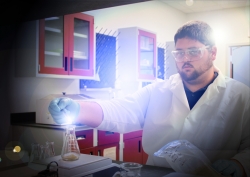So What’s the Difference? Switchgrass Variety Study for Cellulosic-Derived Biofuels
CRAFT Research Assistant Gary Selby is conducting a study using four varieties of switchgrass in an effort to optimize production of cellulosic-derived biofuels. In Selby’s two-pronged study, switchgrass varieties of Alamo, Cave-in Rock, Kanlow and Bluegrass Parkway will be researched to determine which has the highest yield of sugar (specifically glucose, fructose and xylose) after the pretreatment and hydrolysis process. The study will also attempt to determine the most conducive chemical pretreatment process for a multi-biomass feedstock system. “This research will give CRAFT vital information about different switchgrass varieties and the sugars released from each after chemical and enzymatic separation,” says Selby.
Plants, through the process of photosynthesis, capture energy from sunlight and use its energy, along with carbon dioxide and water, to create cellulose and oxygen. Cellulose, once broken down through hydrolysis into sugars such as glucose, is consumable by oil-dense micro-algae used in the production of biodiesel. The identification of the best switchgrass variety for sugar yields, coupled with the identification of the best form of pretreatment for sugar extraction, will help CRAFT optimize its biomass to biofuel process by improving the efficiency of acquiring sugars for algae consumption−a major cost input for the biofuel production process.
Each type of switchgrass is considered a different variety based on its regional adaption ability such as the length of growing season and climate preference. Sugars yields of each variety will first be compared under individual pretreatment conditions utilizing a strong or weak base, sodium hydroxide and ammonia hydroxide respectively. The selection of pretreatment chemicals builds upon earlier CRAFT studies and is important because of the “feedstock-agnostic” approach CRAFT is pursuing in its Cellulosic-Derived Biofuels Initiative which hopes to develop a process for extracting cellulosic material from a variety of biomass sources instead of optimizing for one particular source. It is conceivable that even biomass producers within the state of Kentucky will use different switchgrass crops depending on their individual topography. “Eastern Kentucky is more mountainous, making it more suitable for upland switchgrass varieties while central Kentucky is flatter with a slightly warmer climate which may be conducive to lowland varieties,” states Selby. “It is important for us to know which of these methods perform the best based on each given feedstock.”
After each switchgrass variety sample is chemically pretreated, samples will then be hydrolyzed with a commercial enzyme that breaks down more complex longer chains of sugars into smaller simple sugars. These sugars can ultimately be used as a feedstock in algae fermentation with the non-consumed sugars potentially utilized as co-products like high-value chemicals or bio-plastics.
Contact Information
Amber Overbay
amber_overbay@mymail.eku.edu
859-622-7316
Published on October 06, 2011
